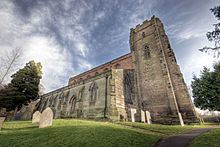The Church of St Chad, Lichfield
| Church of St Chad, Lichfield | |
|---|---|
 |
|
| 52°41′22″N 1°49′15″W / 52.689373°N 1.820925°WCoordinates: 52°41′22″N 1°49′15″W / 52.689373°N 1.820925°W | |
| Location | Lichfield, Staffordshire |
| Country | England |
| Denomination | Anglican |
| Website | The Church of St Chad |
| Architecture | |
| Functional status | Active |
| Heritage designation | Grade II* |
| Designated | 05.02.1952 |
| Architectural type | Church |
| Style | Early English, Gothic |
| Specifications | |
| Materials | Sandstone & Brick |
| Administration | |
| Parish | Lichfield |
| Diocese | Lichfield |
| Province | Canterbury |
| Clergy | |
| Rector | Revd Rod Clark |
| Curate(s) | Revd Joshua Penduck |
| Minister(s) | Revd Elizabeth Wall |
| Assistant | Lizzy Steel |
| Laity | |
| Organist/Director of music | Mitchell Holland |
| Parish administrator | Lisa Mitchell |
The Church of St Chad is a parish church in the area of Stowe in the north of the city of Lichfield, Staffordshire in the United Kingdom. It is a Grade II* Listed Building. The church is located to the north of Stowe Pool on St Chad's Road. The current building dates back to the 12th Century although extensive restorations and additions have been added in the centuries since.
Chad came to Lichfield a few years before he became Bishop of Lichfield in 669 CE for the purpose of religious solitude. He settled in a wood and led an eremitical life in a cell by the side of a spring. From this cell he was known to preach and baptize his converts in the spring. It is believed that the location of Chads cell and spring was in the current churchyard.
A monastery named the station of St Chad was built nearby the spring on the present site of the church around the time of St Chad. Of the original Saxon monastery nothing now remains.
During the 12th Century the monastery was rebuilt as a church in stone and consisted of the nave, two side aisles and a chancel. The west door to the church stood where the tower now stands. The windows were set in gables and the lines of these gables and the rounded arches of the Norman windows in the south aisle are some of the oldest features still visible in today's building.
During the 13th Century the roof was replaced, the gables were dispensed with and the walls built up to the level of the window heads. The Norman windows were replaced with the Early English style pointed windows, still seen today. The south arcade of five bays with octagonal pillars is also Early English as is the chancel and the west doorway.
The Tower on the west side was built in the 14th Century to house the bells. The five-light chancel east window with cusped intersecting tracery was also built during this time as was the font, which is still in use today.
During the Reformation many of the church's assets were confiscated. During the English Civil War the church was occupied by Parliamentary troops who besieged the Close of Lichfield, the church was considerably damaged and the roof had to be rebuilt. At this time the red brick clerestory was added and the single overall roof was replaced by three separate roofs, including a grained roof over the nave and panelled roof in the south aisle.
...
Wikipedia
